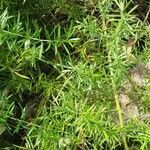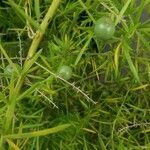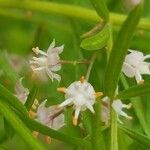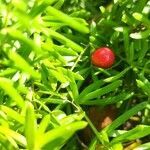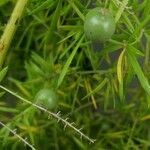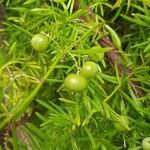Sprawling to pendent herb to scandent subshrub, perennial, roots fibrous and tuberous. Stems to c. 2 m long, often arching, becoming somewhat woody below; young stems lightly grooved. Leaf scales with spines usually developed except on branchlets, reflexed. Spines axillary, pungent, 5–10 mm long. Cladodes (1–) 2–5 per axil, flattened, linear, mucronate to apiculate apex, tapering at base, (10–) 15–25 mm long, (1.5–) 2–3 mm wide. Inflorescence usually an axillary raceme 4–10 cm long, 10–20-flowered; pedicels 5–9 mm long, articulated 2–4 mm from base. Flowers numerous, often paired, bisexual, 4–6 mm diam. Sepals and petals (perianth segments) ovate to oblong-elliptic or narrowly oblong, 3–4 mm long, 1.5–2 mm wide, spreading to reflexed, white or pale pinkish white. Stamens 6, 2.5–3 mm long; filaments 1.5–2 mm long, white; anthers 0.5–1 mm long, orange. Ovary ovoid, 2–2.5 mm long; style 1–2 mm long, capitate or minutely trifid. Berry globular, 5–8 mm diam., red. Seeds 1 to few, 3–4 mm diam.
Spiny climber, up to 3 m high. Stems pale, ribbed when young. Spines short, exserted, recurved. Cladodes 4-6 per fascicle, terete or ridged, apiculate, discoid at base, glaucous-green, 10-40 mm long. Flowers in many racemes, outer perianth segments minutely ciliate; stamens with orange or red anthers; ovary dark; pedicels short. Flowering time Dec.-Mar. Fruit a red berry.
A scrambling plant. It grows from a thick tuberous root growing on the rhizomes or underground stems. The stems are thin and flattened and look like leaves. The flowers are white or pale pink and bell shaped. They are 4 mm long. They are in groups. The fruit is a berry 8 mm across. There are one or more black seeds.
Spiny climber, up to 3 m long, stems pale, ribbed when young, spines short, hooked. Cladodes 4-6 in fascicles, terete, greyish green. Flowers in axillary racemes.
Spiny climber to 3 m, stems pale and ribbed, spines hooked. Cladodes 4-6 in fascicles, terete. Flowers in racemes.
